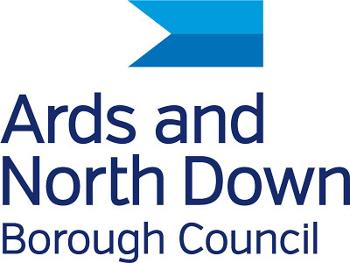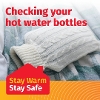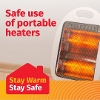Portable heaters and generators: stay warm, stay safe!
During colder months and during periods of poor weather, many people turn to portable heaters for extra warmth. When used safely, they can be a great source of comfort, but they can also pose serious risks if not used safely.
Stay Warm, Stay Safe: make sure you use these appliances correctly by following these essential safety tips.
Safe use of electric space heaters
For safe use of an electric space heater, follow these essential guidelines to reduce the risk of fire, burns, or electrical hazards:
Top Safety Guidelines
- Plug Directly into a Wall Outlet
- Do not use extension cords or power strips.
- Heaters draw a lot of power and can cause cords to overheat, leading to fires.
- Always check the cord, plug and unit for any damage or frayed wires before use.
- Also, be mindful of trailing cables. You don't want anyone to pull the cable and knock the heater over or even worse, trip and fall onto it.
Keep a 3-Foot Safety Zone
- Maintain at least 3 feet (1 metre) of clearance around the heater.
- Keep it away from:
- Curtains
- Bedding
- Furniture
- Paper and other flammables
Never Leave It Unattended
- Turn it off when you leave the room or go to sleep.
- If you need overnight heating, use a heater specifically rated for overnight use with proper safety features.
Use Heaters with Built-in Safety Features
- Look for models that include:
- Tip-over shutoff
- Overheat protection
- CE mark
Avoid Use in Wet or Damp Areas
- Do not use standard electric heaters in bathrooms or laundry rooms unless they are specifically rated for moist environments (i.e. marked as bathroom-safe).
Place on a Flat, Hard, Non-flammable Surface
- Do not place on beds, furniture, carpets, or rugs - check instructions to see where the heater can be used safely.
- Never use on an unstable or soft surface where it could tip over or overheat.
Inspect Regularly
- Check the cord and plug for wear, fraying, or damage.
- Clean dust and lint from vents and grilles regularly to prevent it overheating. Unplug and ensure heater cool before cleaning.
Don't Use as a Dryer
- Never place clothes, towels, or other items on or near the heater to dry them.
Use a Timer or Thermostat
- This prevents overheating and saves energy.
- Many models come with a programmable thermostat or auto shut off.
Use Only in Enclosed, Supervised Spaces
- Not for outdoor or unsupervised use (like garages or sheds) unless the heater is rated for that environment.
The fire risk of emollients
- Emollients are used to treat various skin conditions and are extremely flammable. Therefore, when they're absorbed into clothing and fabrics, they make the clothing and fabric much more likely to catch fire.
- This is another reason why heaters must be placed away from people, fabrics and furniture.
Safe use of gas space heaters
Gas space heaters can be safe and effective if used properly and suitable for indoor use. However, improper use can lead to serious hazards such as carbon monoxide poisoning, fires, or explosions. Here's a practical guide for choosing and using gas space heaters safely:
Check certification
- Make sure the heater carries the CE mark before purchasing.
Before you use your heater:
Read the manual
- Always follow the manufacturer's instructions for installation, operation, and maintenance.
Inspect the heater
- Inspect for any signs of damage.
Ensure Proper Ventilation:
- Use vented heaters when possible.
- Unvented (vent-free) heaters should only be used in well-ventilated areas.
While Operating the Heater
- Keep it stable.
- Place the heater on a flat, level surface, away from foot traffic, children and pets.
Maintain Clearance:
- Keep at least 3 feet (1 metre) between the heater and anything flammable (furniture, curtains, bedding).
Never Leave It Unattended:
- Turn it off when leaving the room.
- Turn it off before sleeping.
Use a Carbon Monoxide (CO) Alarm:
- Essential if using any gas appliance indoors. Test it monthly.
Ventilation Is Key:
- Always keep a window open to allow fresh air in and reduce CO buildup.
- Only use in well-ventilated spaces.
- Never use outdoor heaters (like propane or kerosene) indoors unless they're specifically approved for indoor use.
Things You Should Never Do
- Don't use it in small, enclosed spaces (e.g., bathrooms, small bedrooms) unless the unit is specifically designed for that.
- Don't use propane heaters indoors.
- Don't block air intake or exhaust.
- Don't use it to dry clothes or heat food.
- Don't place near water or use in bathrooms or damp areas.
- Don't tip or tilt the unit during operation.
- Never leave on when leaving the room or sleeping.
Maintenance Tips
- Clean regularly to remove dust and debris.
- Have the unit serviced annually by a qualified gas safe registered engineer (check www.gassaferegister.co.uk).
- Repairs must only be carried out by a gas safe registered engineer.
Safety Features to Look For
- Tip-over shutoff
- Overheat protection
Fire Safety Tip:
- Install smoke alarms and carbon monoxide alarms in every room where a heater is used.
The fire risk of emollients
- Emollients are used to treat various skin conditions and are extremely flammable. Therefore, when they're absorbed into clothing and fabrics, they make the clothing and fabric much more likely to catch fire.
- This is another reason why heaters must be placed away from people, fabrics and furniture.
Warning Signs of Carbon Monoxide Poisoning
- Headache, dizziness, nausea, confusion, fatigue.
- If you suspect CO poisoning: Turn off the heater, leave the area immediately, and seek fresh air and medical help.
Safe use of diesel space heaters
During colder months and poor weather space heaters can be a safe and effective way to keep warm if used properly. Here's a practical, guide to the safe use of diesel space heaters:
Use in the Right Environment
- Well-ventilated areas only — diesel heaters consume oxygen and produce fumes (especially Carbon Monoxide - CO).
- Ideal for outdoor use, garages, barns, warehouses, and construction sites.
- Never use in small or enclosed indoor spaces without ventilation.
Follow Manufacturer Instructions
- Always read and follow the manufacturer's instructions.
- Use correct fuel only.
- Never substitute with petrol or other flammable liquids.
Provide Adequate Ventilation
- Open doors, windows, or vents to allow fresh air in and exhaust out.
- Use a CO alarm in any partially enclosed space.
- For indoor applications, use vented diesel heaters only (connected to a chimney or flue).
Safe Placement
- Place on a level, stable surface, away from foot traffic.
- Maintain at least 3 feet (1 metre) of clearance on all sides.
- Keep away from flammable materials (curtains, paper, fuel cans, etc.).
Fuelling Safety
- Turn off and cool down the heater before refuelling.
- Use a funnel or pump to avoid spills.
- Store diesel fuel in approved containers, away from ignition sources.
- Never refuel indoors or near open flames.
Check for Safety Features
- Look for heaters with:
- Overheat protection
- Tip-over shutoff
- Flame-out sensor
Thermostat controls
- Don't leave the heater unattended while running.
- Don't use in bedrooms, basements, or other enclosed areas.
- Don't run it near children or pets.
- Don't ignore fuel odours or visible smoke/fumes — shut down and ventilate immediately.
Emergency Preparedness
- Install a carbon monoxide alarm near the heater.
- Have a fire extinguisher rated for fuel fires nearby.
- Know the signs of CO poisoning: headache, nausea, dizziness, fatigue, confusion. Leave the area at the first sign of any of these symptoms and go to a well ventilated area seeking medical assistance if required.
Safe use of Generators
Generators are a useful back up for providing electricity during power cuts. Failure to use a generator safely can have catastrophic results. Protect yourself and those around you by following these steps:
1. To prevent backfeeding (excess electricity flowing back into the network potentially putting your neighbours and workers at severe risk) never connect directly to your domestic electrical system by plugging it into a wall outlet.
2. Only use a generator with a CE mark or UKCA or UKNI mark - to show it meets all relevant safety requirements.
3. Read and follow the manufacturer's instructions.
4. Only operate generators outdoors at least 6 metres/20 feet away from windows/doors/vents. Partially open spaces, garages and sheds are unsuitable for use of generators. Ensure there is adequate ventilation around the generator and direct exhaust fumes away from occupied areas.
5. Protect the generator from rain and standing water.
6. Only use appropriate heavy-duty, outdoor-rated extension cords designed for generators and check for damage before use. Never overload the generator by connecting too many appliances.
7. Regularly inspect the generator for damage and ensure it is maintained by repairing/replacing damaged parts promptly.
8. Ensure refuelling is only carried out when the generator has cooled down completely. Fuel must be stored safely in properly labelled approved safety containers outside of living spaces away from ignition sources.
9. Use suitably located Carbon Monoxide (CO) alarms inside your home/outbuilding/area being serviced by the generator.
10. Be aware of the symptoms of CO exposure: headaches, nausea, breathlessness, dizziness, collapse and loss of consciousness. At the first sign of any of these, act immediately by moving to a well-ventilated area and seek medical assistance if required.
Stay Warm Stay Safe
The Stay Warm Stay Safe campaign highlights safety tips for staying warm and safe during the colder months.
Electric Blankets and Heated Throws
- Buy a new electric blanket at least every 10 years.
- Always remember to unplug the blanket/throw when not in use.
- Never use an electric blanket/ throw at the same time as a hot water bottle.
- Nor use with an air flow mattress or emollient creams.
- Store flat to avoid damage - do not fold or roll up tightly.
- Be vigilant to any signs of wear or damage to the blanket/throw.
Hot Water Bottles
- Do not use boiling water and do not overfill the bottle.
- Avoid direct skin contact - place bottle inside a cover.
- Check the year of manufacture by looking for the flower symbol on the hot water bottle.
- Replace at least every 2 years - rubber deteriorates over time.
- Babies and people with certain medical conditions which includes loss of sensation should not be given hot water bottles
Overloaded Electrical Sockets
- Do not overload electrical sockets/extension leads/ adaptors as this can result in overheating and cause fires.
- Check the current rating of the extension lead on the instructions or label. Do not plug in appliances with a greater current rating than the extension lead.
- Do not plug one extension lead into another extension lead.
- Signs of damage include sparks, smoke, blackness or scorch marks.
- Never attempt to repair damaged sockets, extension leads/adaptors
Electrical Chargers
- Overcharging of mobile phones, tablets, laptops, e-bikes, e-scooters, e-cigarettes and other devices can cause fires. Switch off when charging has finished.
- Do not charge e-bikes and e-scooters in fire escape routes.
- Use only manufacturer recommended batteries and chargers.
- Avoid storing/charging batteries in very hot or cold areas.
- Charge on a non-flammable surface and don't leave devices charging unattended for long periods.
- Never cover chargers or charging devices.
- Do not use your device with its power lead or battery pack attached in bed.
This information is also available as a downloadable leaflet: Stay Warm Stay Safe leaflet (PDF, 1 MB) (opens new window)









